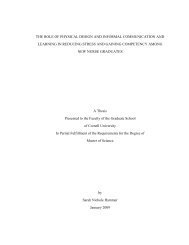The Patient Room: what is the ideal solution? - Cornell University
The Patient Room: what is the ideal solution? - Cornell University
The Patient Room: what is the ideal solution? - Cornell University
Create successful ePaper yourself
Turn your PDF publications into a flip-book with our unique Google optimized e-Paper software.
Airborne Infection:<br />
<strong>Patient</strong> <strong>Room</strong> and Infection Control<br />
Sources of some airborne pathogens can be construction and renovation activities or ventilation system contamination and<br />
malfunction. Th<strong>is</strong> could mean dust and mo<strong>is</strong>ture accumulating in <strong>the</strong> heating, ventilation, and air conditioning systems or <strong>the</strong><br />
failure of <strong>the</strong>se systems. In one study, <strong>the</strong>re was an outbreak of invasive pulmonary aspergillos<strong>is</strong> (IPA) in a ward housing acute<br />
leukemia patients. Th<strong>is</strong> ward had natural ventilation and <strong>the</strong> hospital was doing extensive construction and renovation. <strong>The</strong> infection<br />
rate climbed to 50%. Some of <strong>the</strong> patients were moved to ano<strong>the</strong>r ward with HEPA filters and for <strong>the</strong> following three years none of<br />
<strong>the</strong>m developed IPA. However, those kept in <strong>the</strong> regular ward had a 29% rate of infection during <strong>the</strong> same time (Joseph 2006).<br />
Contamination and malfunction of HVAC systems can pose a threat of its<br />
own. A specific MRSA study where six patients and one nurse were<br />
infected found that ventilation grills in two patient bays were harboring<br />
MRSA. When th<strong>is</strong> happened , <strong>the</strong> ventilation system would shut down<br />
daily during its cycle, which created negative pressure so air from <strong>the</strong><br />
patient ward got sucked into <strong>the</strong> ventilation system. When <strong>the</strong> system<br />
came back on, <strong>the</strong> infected air came out to infect patients and staff<br />
(Joseph 2006).<br />
<strong>The</strong>se previously d<strong>is</strong>cussed cases seem preventable now that we know<br />
<strong>what</strong> caused <strong>the</strong>m. Indeed <strong>the</strong>re are processes and steps to take in order<br />
to improve air quality. Using HEPA filtration <strong>is</strong> one way to control air<br />
pollutants. Some believe <strong>the</strong> most effective way to combat <strong>the</strong>se<br />
pollutants <strong>is</strong> to control <strong>the</strong>m at <strong>the</strong> source (Joseph 2006). Joseph’s “Steps<br />
involved in providing clean filtered air in <strong>the</strong> hospital,” are demonstrated in<br />
<strong>the</strong> graphic.<br />
16







